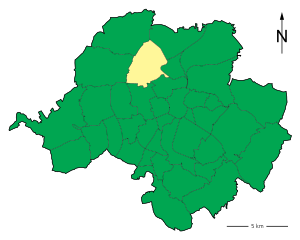Chemnitz-Borna-Heinersdorf
|
Borna-Heinersdorf district and statistical district No. 13 of Chemnitz |
|
|---|---|
| Coordinates | 50 ° 51 '50 " N , 12 ° 53' 50" E |
| surface | 8.08 km² |
| Residents | 6578 (Dec. 31, 2013) |
| Population density | 814 inhabitants / km² |
| Incorporation | Jul 1, 1913 |
| Post Code | 09114 |
| prefix | 0371 |
| Transport links | |
| Highway |
|
| Federal road |
|
| Train | C11 |
| bus | 21, 22, 46, 63, 76, 96, N18 |
Borna-Heinersdorf is a northern part of Chemnitz . In this district is the Crimmitschauer Forest , which originally belonged to the Altendorf district. The Röhrsdorfer Höhe , south of the “Chemnitz-Mitte” motorway junction, represents the northern edge of the Erzgebirge basin.
Neighboring districts are Glösa-Draisdorf and Furth in the east, Schloßchemnitz and Altendorf in the south, Röhrsdorf in the west and Wittgensdorf in the north.
history
Borna
The former two-row forest hoof village Borna was first mentioned in a document in 1288 ("zum Bornn" = settlement at the source or well) . It belonged to the Blankenau lordship and was parish to Glösa. It was not until 1950 that Borna received its own church, the Gnadenkirche . Borna was connected to Heinersdorf through a common school community since the 19th century.
Industrialization (including foundries, brickworks) began around 1911/12. Borna has been incorporated into Chemnitz since 1913. From the 1920s, favored by the proximity to the city of Chemnitz, emerged, mainly in the outskirts of Borna, workers' housing estates and several small settlements (Frischbornsiedlung, “Borna Berg” settlement, Wüstenrotsiedlung…). In 1929, a modern low-rise school was built by Fred Otto on Bornaer Berg (formerly Hindenburg school , later secondary school for the physically handicapped ). A few years later a multi-storey panel building school ( POS Ernst Schneller ) was built below the low-rise building.
Borna has had a railway connection since the Chemnitz – Leipzig railway line opened in 1872. The railway viaduct over the Bahrebach and the autobahn ( A4) that was built in 1936 is now a technical monument. The industrial line, which opened in 1903, through the Crimmitschauer Forest between Chemnitz-Altendorf and Borna has now been shut down and dismantled.
Heinersdorf
Heinersdorf, founded as a single row forest hoof village, was first mentioned in 1338 as "Heinrichsdorf" (village of a Heinrich) . The spelling "Heinerschdorff" dates back to 1540. The sewage treatment plant on the Chemnitz River was built between 1912 and 1916. In 1922, Heinersdorf was incorporated into Chemnitz. Ten years later the settlement on the Bahrebach was built , and in 1936 the Reichsautobahn .
Lordship of Blankenau
On May 5, 1296, the rule in connection with the brothers Albert, Friedrich and Hermann von Blankenau (as "Blankenowe" ) was mentioned for the first time. The Reichsministerialien von Gersdorf is presumed to be the founder of the castle and rule. Before the end of the 14th century the villages Furth, Glösa, Borna, Heinersdorf and Draisdorf belonged to it. In 1375 the rule and the villages fell to the Chemnitz Benedictine monastery , and in 1548 to the Chemnitz office .
The old Blankenau Castle was located between the Chemnitz River, the A4 and Heinersdorfer Strasse . In 1874, the later owner of this site had the remains of the complex that were still recognizable up to then leveled.
Bismarck Tower
On the northern edge of the Crimmitschauer forest was Bismarck Tower built in 1905-06. The restaurant "Bismarckschlößchen" joined him. Until its destruction in World War II , the tower and the restaurant were a popular excursion destination for the people of Chemnitz. The tower was named after the former German Chancellor Prince Otto von Bismarck .
traffic
Through the district leading B 95 ( Leipziger Strasse ) and in the north the A 4 . Borna-Heinersdorf can be reached with the city bus routes 23, 21, 46, 76 and N18 for night traffic. The railway line to Burgstädt / Leipzig has a stop in Borna on Sandstrasse , and the Küchwald train station begins in the southeast of the district . Both are served hourly by the Chemnitz City Railway .
The Heinersdorf stop on the Chemnitz Valley Railway was closed in 1977. The Chemnitz-Borna loading point was on the closed Küchwald – Obergrüna railway on the “Abendleite” road.
The former tram line 4 ran along Leipziger Strasse until 1975, coming from Hartmannstrasse . The final stop was between Bornaer and Wittgensdorfer Straße at the former “Grüner Hof” inn.
See also
Web links
- historisches-chemnitz.de about Borna and Heinersdorf
- Borna in the Digital Historical Directory of Saxony
- Heinersdorf in the Digital Historical Directory of Saxony
- History of the Bismarck Tower in Chemnitz
- History of Fred Otto's Hindenburg School
- altes-chemnitz.de about Borna
- Botanical Garden




